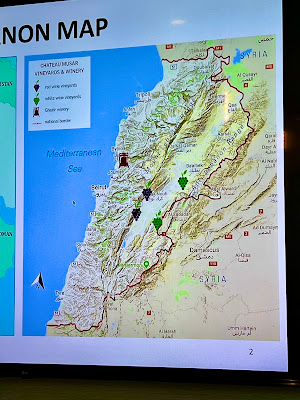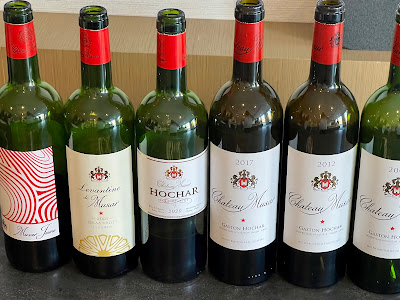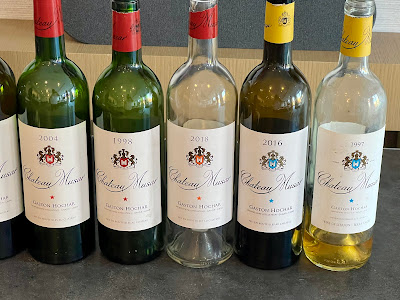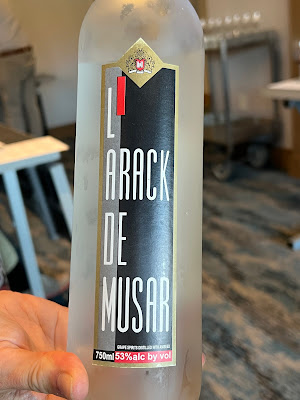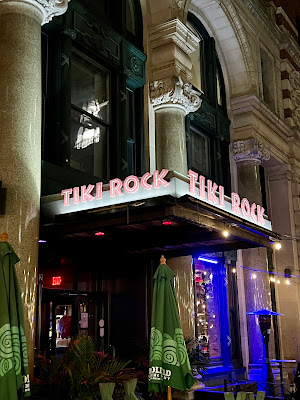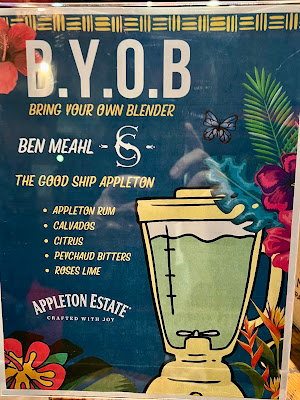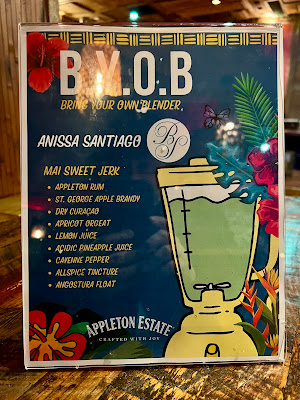In the U.S., the best known winery in Lebanon is Chateau Musar, and the quality of their wines is an excellent reason for their renown. I've been a fan of their wines for over fifteen years, and was fortunate last week to attend a trade seminar for those wines, presided by Marc Hochar, one of the third-generation owners of Chateau Musar.
I'll initially note that the logo above has a motto in Latin, "Labor Omnia Vincit," which translates as "work conquers all." The phrase is adapted from a line in Virgil's Georgics, "Labor omnia vicit / improbus", which roughly translates as "steady work overcomes all things." This motto is also the motto of the state of Oklahoma.
Around the 2nd century A.D., a great Temple to Bacchus, the Roman god of wine, was constructed by the Romans in the ancient city of Baalbek, later called Heliopolis by Alexander the Great. The temple is huge: about 200 feet long, 100 feet wide and nearly 100 feet high. The temple contains numerous depictions of vines and the enjoyment of wine.
Unfortunately, in the 7th century, when Lebanon was conquered by the Islamic Caliphate, wine production suffered, although Christians were still permitted to produce wine for religious purposes. It wouldn't be until the 19th century that the modern wine industry rose in Lebanon, spurred on by Jesuits and the French. A few of the wineries which were established in the late 19th century still exist.
The country of Lebanon is about 120 miles long and 30 miles wide, bordered by Syria, Israel, and the Mediterranean Sea. It has a population of nearly 6 Million people. There are two main mountain ranges, the Anti-Lebanon Range (or Eastern Lebanon Range) and the Mount Lebanon Range, and between the two is the Bekaa Valley, an area perfect for viticulture. In the Anti-Lebanon range, the highest point is Mount Hebron.
Marc stated that Lebanon doesn't fall under the categories of either Old World or New World wines. Instead, it's part of the Ancient World wines, similar to other countries such as Georgia, Turkey and Armenia. Almost thirty years ago, in 1996, there were only about 40 wineries in Lebanon, but over twenty years later, in 2020, the number doubled to about 80 wineries. However, please note that these numbers are tentative, as the wine industry lacks an official, regulatory body. Whatever the actual number of wineries, only a handful currently export their wines to the U.S.
The photo above is of Marc Hochar, one of the owners of Chateau Musar, and he led the seminar and wine tasting, providing much fascinating information. He was personable and knowledgeable, humorous and easy going. He makes an excellent ambassador for the wines of Chateau Musar.
In 1930, Gaston Hochar, who was only twenty years old, planted vineyards in the Bekaa Valley and founded Chateau Musar, inspired by his recent travels to Bordeaux. He began wine making in the basement of an old convent owned by a relative. Serge Hochar, his eldest son, would eventually take over the control and management of the winery in 1959, and Serge eventually created the Chateau Musar Rouge style. Serge had two sons, Gaston and Marc. Unfortunately, due to the civil war in Lebanon (1975-1990), much of the family moved, eventually settling in Paris in 1983. Marc got involved in investment banking, and spent about twenty years in that career, before deciding to return to Lebanon and get involved in the winery in 2010.
From the map above, you can see the location of Musar's vineyards and their winery. All of the vineyards are in the southern section of the Bekaa valley, where the climate is quite dry and there are about 300 days of sun each year. Because of the heat, the vines are grown at higher altitudes, with cool nights helping to balance the day time heat. The red grapes are grown at about 3000 feet above sea level, while the white grapes are grown even higher. The soils are mostly clay or gravel with limestone bedrock. The vineyards are all bush wines, an old pruning style, so all of the work in the vineyards must be done by hand.
Lebanon lacks an appellation system, except the general "Lebanon" designation, so wine makers can plant any grape they desire. As for red grapes, Musar grows Cabernet Sauvignon, Cinsault, Carignan, Syrah, Tempranillo and Grenache. Cinsault has been grown in Lebanon since the 1850s, when Jesuit monks planted it in the Bekaa Valley. Carignan also seems to have been first planted in the 19th century in Lebanon. French winemakers had previously planted grapes in Algeria, so it was easy for them to start planting French grapes in Lebanon as well. There don't appear to be any indigenous red grapes still existent in Lebanon. The main white grapes Musar uses are both indigenous Lebanese grapes: Obeideh and Merwah, some of which are old vines, having been planted in 1920.
As the winery is near the Mediterranean coast, it can take about three hours to transport grapes from the vineyards to the winery, although in 1984, there were significant problems, causing transport to take a lengthier path, and it took five days to reach the winery. The Musar winemaking philosophy is one of non-intervention as they believe they "tend" to their wines as they develop, rather than "make" them. It is more a matter of "timing" not "making." They use natural yeasts and don't use any "man-made additions."
Marc also stated that "wine making is a gamble," as you never know what you will get. He continued that there aren't bad vintages, just "different vintages," and sometimes it may take years for a more difficult vintage to get good. As for the current vintage, despite the element of war in the region, they had no difficulties with the harvest or getting the grapes to the winery. The only potential problem that might arise could be difficulty in transporting the finished wines out of the port.
Marc started the seminar with an intriguing story about why Musar wines may taste better on a sunny day rather than a rainy day. He noted that Burgundy wines can taste very good on rainy days. So why the difference? At one time, Marc tasted his wines on a Flower Day according to the Biodynamic calendar, when his wines should have been expected to show well. However, the wines didn't taste as good as they should have tasted. On a Root Day, when his wines were supposed to show poorly, they actually tasted excellent. He continued to monitor the Biodynamic calendar with his tastings but his wines didn't conform to those expectations.
Instead, Marc found that the Musar wines generally tasted better on sunny days rather than rainy ones. Marc developed his own theory about this phenomenon. He stated that Musar makes more natural wines, from organic vineyards, and that wine is alive, and continues to evolve in the bottle and glass. If plants, like grape vines, are alive, they may possess a memory and even feelings, and that memory may be passed onto the wine. The plants may "recall" the 300 days of sunshine and how it made them grow so well, so the wine may "embrace" sunny days, presenting their best selves. In Burgundy, they tend to have more rain, so those wines may also present their best selves on rainy days.
For all of their red wines, Chateau Musar uses a blend of three grapes, and two are always the same: Cabernet Sauvignon and Cinsault. Cabernet is seen as masculine, opaque, tannic and with dark red berries. The younger wines can be harsh because of their tannins. On the other hand, Cinsault is more feminine and silky, with low tannins and lighter red berries. They are like two extremes which then balance each other out, complimenting each other. Marc stated that few other wineries make such a blend of Cabernet and Cinsault.
The objective of Musar is to "build the balance of the wine," almost like using Lego building blocks. The third grape varies in each specific red label. All of the grapes are fermented separately, and then will be blended together, after a period of 6-24 months. I'll also note that Musar relies on low yields in the vineyards as well.
In 1977, Serge Hochar created the blend for their top red wine, the Chateau Musar Rouge. This was Cabernet Sauvignon, Cinsault and Carignan, and that blend has not changed. For this wine, the grapes are fermented in cement and then racked after six months. They are then aged in mostly used French oak for about a year. After three years, the wines are blended and aged for an additional 3-4 years in the bottles, with each Rouge generally released 7 years after the harvest.
Volatile acidity (VA) basically is a measure of a wine's gaseous acids, and it's considered a flaw by numerous winemakers and wine lovers, although sometimes it depends on the amount of VA in a wine. High amounts of VA can produce off odors, and some people are sensitive to even small amounts of VA. Natural wines tend to have higher amounts of VA than other wines. Marc stated that VA is an important element of Musar wines, that when you smell their wines, the VA jumps out of the glass. Without VA, the wine has no life, no vibrancy. Personally, I haven't found the VA in any of the Musar wines I've tasted to be off putting and I haven't heard complaints from my wine lover friends about VA in the Musar wines.
Marc noted that the Chateau Musar wines are often compared to Bordeaux, Rhone and Burgundy wines, dependent on the age of the wines. He added that there are basically 3 seasons for their wines, based on their age. First, the Spring wines are young wines, aged 6-10 years, and possess fresh fruit flavors. Second, there are the Summer wines, aged 12-15 years, and as the fruit gets baked by the sun, you get more stewed fruit flavors, more concentration. Finally, there are the Autumn wines, the older ones, where the "fruit goes into the earth," and these wines show more earthy, mushroom, and barnyard flavors.
************
Now, let's take a brief detour into the early history of Chateau Musar in the U.S. Maybe the first mention of Chateau Musar in the newspapers was in the Chicago Daily News (IL), March 9, 1963. In an article about Beirut, it was briefly noted, “Lebanon does produce tasty wines, particularly the red Sahra and Chateau Musar.” At that time, the Musar wines were not yet available in the U.S. so this brief mention probably didn't spur much interest in the wines.
Ten years later, it appears that the Musar wines had finally become available in the U.S., although it's possible they were primarily found in Texas at this point. The Houston Chronicle (TX), November 8, 1973, published a column about the Winetasters, a local group of wine lovers who met once a month to taste and rate inexpensive wines for value. At a recent tasting, they had sampled and rated three Musar wines, two whites and a red. Their main concern seemed to be the aromas of these wines.
Ten years later, it appears that the Musar wines had finally become available in the U.S., although it's possible they were primarily found in Texas at this point. The Houston Chronicle (TX), November 8, 1973, published a column about the Winetasters, a local group of wine lovers who met once a month to taste and rate inexpensive wines for value. At a recent tasting, they had sampled and rated three Musar wines, two whites and a red. Their main concern seemed to be the aromas of these wines.
First, the non-vintage Chateau Musar White Cuvee Reserve (about $4.29) received 2 Good, 4 Fair, and 1 Poor ratings. It was noted, “It had a strong somewhat medicinal nose totally unrelated to the taste of the wine.” Second, the 1966 Chateau Musar White Grand Cru (about $4) received 3 Good, 3 Fair, and 1 Poor ratings. It was said, “Again, the nose (or aroma) had nothing to do with the taste of the wine. It was unusually flowery and a darker gold than the first one.” One of the tasters also described it as “more like a French Graves than anything else.” Third, the 1966 Chateau Musar Red Grand Cru (about $4) received 4 Good, 2 Fair, and 1 Poor ratings. It was also stated, “Aromatic nose. Not unacceptable, just odd.”
Five months later, the Houston Chronicle (TX), April 18, 1974, published another column about the Winetasters. They had conducted a tasting with numerous Chianti wines, but also blind tasted three other wines, including a Bordeaux and the 1966 Chateau Musar Red. As for the Musar, it was stated that, “Several Winetasters thought it was the best wine we had all evening.” No issue with its aroma was noted, and it seemed to appeal even more than at the prior tasting. Bottle variation might have played a role in their prior wine tasting.
The first advertisement for Chateau Musar may have appeared in the Houston Post (TX), June 14, 1974. In a large liquor store ad, it was mentioned that the 1966 Chateau Musar was "a Red Bordeaux Type Wine from Lebanon" and had received "Rave Reviews." The wine regularly sold for $3.59, but was on sale for $2.98. In comparison, the ad also mentioned a few other wines, including: Mateus Rose ($1.75), Baron Philippe de Rothschild Mouton Cadet ($2.50) and Harvey's Bristol Cream ($4.75).
The Express-News (TX), April 2, 1976, had a liquor store ad mentioning “Chateau Musar Rubis,” a Rosé from Lebanon, for $1.46.
The first non-Texas advertisement was in the Chicago Tribune (IL), March 2, 1978. In a liquor store ad, it was noted you could save 50% on the Chateau Musar Grand Cru 1966 or 1970. It now cost only $1.99, rather than the usual price of $3.98. The ad also stated, “If you like French Bordeaux & Burgundy, you’ll love Chateau Musar.” A few years then passed without any other newspaper mentions of Musar wines.
A lengthy, and very positive, article about Chateau Musar then appeared in the Winston-Salem Journal (NC), April 2, 1981. Titled, “Cabernet From Lebanon Has Astonishing Quality,” and from the New York Times News Service, the writer discussed a wine he had blind tasted at a Manhattan restaurant. He stated, "The wine was dark red, almost black, and rich with the fruit of the cabernet sauvignon grape, conveying a flavor intensity characteristic of the best Bordeaux or perhaps one of the great California estates where the Cabernet also achieves superb quality." The writer also felt that the wine was likely from Napa, maybe the 1970 or 1974 vintages.
He and the other tasters were shocked to learn the wine was actually the 1970 Chateau Musar. He then added, "To discover a cabernet of such quality from Lebanon was astonishing so I set out to learn more about it." The article also noted that Bacchus Selections, an importer and distributor, had brought the Musar wines into the U.S. but stopped doing so about a year ago. Then, Jack Callaghan, a former Bacchus representative, left the company a year ago and brought the Musar inventory with him. Callaghan opened a Wine Shop at 345 Lexington Avenue, selling the 1972 Musar ($5.99) and the 1975 Musar ($3.69).
The writer sought out additional vintages of Musar, eventually acquiring the 1970, 1969, 1967 and 1964 vintages. He then put them into a blind tasting against two 2 well known California Cabernets and two famous Bordeaux wineries. The California wines included the 1975 Robert Mondavi ($11.99) and 1976 Clos du Val ($9.65) while the Bordeaux included the 1966 Chateau Grand-Puy-Lacoste and 1970 Chateau Lascombes (both which sell for $25-$50). The writer concluded, "Clearly the best was the 1964 Musar which was fruity, rich, tannic and textured, with a classic Bordeaux bouquet of black currants.”
This article was also reprinted in various newspapers across the country including in California, Florida, Georgia, Hawaii, Illinois, Indiana, Kentucky, Maryland, Oregon, South Carolina, and Texas. So, people all over the country learned about the quality of Chateau Musar wines, and it's very likely it garnered much interest from wine lovers, especially those keen to determine for themselves how the Musar wines held up against California Cabernet and French Bordeaux. This might have been the major breakthrough for Chateau Musar wines in the U.S.
The Daily Register (NJ), December 2, 1981, had this advertisement for the 1975 Chateau Musar, noting it was "an excellent red bordeaux style wine that has won many medals. This wine is equal to the great growths of bordeaux." The price is about double from that mentioned in the above April 1981 article. Why had the price jumped so high in nine months? An answer came in another newspaper article.
The Citizen Register (NY), January 20, 1982, provided more raves about the wines of Chateau Musar. It stated, “A littler less than a year ago, before a very successful promotion campaign began, vintages such as 1972 could be found gathering dust on store shelves for about $6. No more; they’ve been discovered and I’ve been reading praises for them locally and in foreign journals for several months now.” The article continued, “With that praise has come a tightening of supply—most are on allocation-and increased prices. You might find the 1975 Musar, a full-bodied, strong finishing red much like a Pomerol, in stores at $7.50, and the 1972, a lighter, more elegant wine at about $10.” Thus, its popularity was the reason for the higher price in the December 1981 liquor ad.
Finally, the article concluded, “Still, the question is, why a Lebanese wine, and the answer is that the combination of soil, climate, dedication and skill have produced a quality wine in an unlikely place.”
We began the tasting with their three "Jeune" wines, which are their "young" and least expensive wines (about $27-$30). They are all unoaked and produced to be fruit-forward, accessible and easy drinking wines.
Now, onto some notes about the various Musar wines I tasted during the seminar. Marc noted that we would be tasting the different vintages in order of younger to older wines, so that the older wines wouldn't overpower the subtleness of the younger wines. He also mentioned that you can drink Musar wines when they are young, as they aren't too bold, but that their complexity builds over time so they are worth storing away as well.
Overall, I found the Musar wines to generally be elegant and complex, approachable and ready to drink upon release. However, I experienced some of the aged Musar wines, and they evidenced the great potential of these wines if you can lay them down for a number of years. These are wines which should greatly appeal to most wine lovers, and should encourage you to also seek out other wines from Lebanon.
We began the tasting with their three "Jeune" wines, which are their "young" and least expensive wines (about $27-$30). They are all unoaked and produced to be fruit-forward, accessible and easy drinking wines.
The 2022 Musar Jeune Rosé is produced from a blend of Cinsault and Mourvèdre, using the saignée method. The wine is fermented in cement lined vats and released about a year after the harvest. It was a pale pink color, with a fruity aroma, and on the palate it was crisp and dry, with pleasant red fruit flavors and a nice finish. Easy drinking on its own or with paired with food.
The 2022 Musar Jeune Blanc is produced from a blend of Viognier, Vermentino, and Chardonnay. It was fermented in cement lined vats and released about a year after the harvest. With a light golden color, it was aromatic and on the palate it was dry and crisp, with an intriguing and complex blend of flavors, including apple, pear, floral notes and subtle spices. With a lengthy finish, this wine was delicious. This was my favorite of the three Jeune wines.
The 2021 Musar Jeune Rouge is produced from a blend of Cabernet Sauvignon, Cinsault, and Syrah. The Syrah first became the third grape in this wine in 2005. This dark colored wine has a deeper nose of black fruits and spice. On the palate, it is fuller bodied, with noticeable but restrained tannins, and flavor of black cherry, raspberry and plum, accented by spice notes, especially on the moderately long finish. This is a wine best paired with meat or other hearty dishes.
We then moved onto the 2021 Levantine De Musar (about $35), which is produced from a blend of Cabernet Sauvignon, Cinsault, and Tempranillo. They have been growing Tempranillo for about 12 years, having planted it due to the effects of climate change. Another effect is that they now harvest about two weeks earlier than they once did. It took about three months to come up with the name of this wine, and the first vintage was in 2016. This is a small production wine, only about 10% of the production level of the Musar Jeune Red. This unoaked wine is silky smooth, with low tannins, and delicious flavors of red and black fruit, and subtle spice notes. If you enjoy Spanish reds, you will likely enjoy this wine. I very much enjoyed the Levantine, and think it would work well as a Thanksgiving wine.
The 2020 Hochar Pere Et Fils (about $45) is produced from a blend of Cabernet Sauvignon, Cinsault, and Grenache. It was fermented in cement vats and then aged in French oak. It's only released every four years. It's a bigger wine than the Levantine, with stronger tannins, but they are far from overpowering. It's a balanced wine, with dominant black fruit flavors, a spicy element, and a lengthy, pleasing finish. This is a wine you should probably pair with meat or other hearty dishes.
We then moved onto four vintages of their flagship wine, the Chateau Musar Rouge, which is produced from a blend of Cabernet Sauvignon, Cinsault, and Carignan (from organic vineyards). Robert Parker once reviewed the 1995 Chateau Musar Rouge, awarding it only 83 points. However, the 1995 vintage is very popular with wine lovers and sells out each time it is made available. Marc stated he feels that the Musar wines are too elegant, and not bold enough, for Parker's tastes.
The 2017 Chateau Musar Rouge (about $65-$75) underwent a lengthy fermentation in cement vats before aging in French oak for a year. The wine is then typically released 7 years after the harvest. With an alluring aroma, this wine is silky and elegant, with mild tannins, and a complex melange of flavors, including both red and black fruits (like black cherry and plum), subtle spices, and hints of herbs. Well balanced, with a lengthy and pleasing finish, it may remind you of a fine Bordeaux. It's very approachable and delicious, and you could even enjoy it on its own, although it would pair well with a variety of foods. This wine has an excellent aging potential, although it's ready to drink now.
The 2012 Chateau Musar Rouge is from an outlier of a vintage, and possesses more residual sugar than normal, about 5+ grams. They now ensure that their wines have no more than about 3 grams of residual sugar. Thus, this wine will tend to taste younger than its actual age, and as it ages, it will become more balanced and likely taste similar in some respects to an Amarone. I found this wine to be smooth and elegant, with a bit less juiciness in the fruit flavors, and it was also very approachable with a lengthy finish. There was a touch more sweetness to the wine, but it was still basically dry.
The 2004 Chateau Musar Rouge was a more elegant and ethereal wine with much complexity and subtleties. Each sip seemed to bring something new to my palate. The fruit was still bright and there was so much life still in this wine. It was pure silk, well-balanced, and with a nearly endless and satisfying finish. Words cannot properly capture the magic of this wine. Highly recommended!
The 2004 Chateau Musar Rouge was a more elegant and ethereal wine with much complexity and subtleties. Each sip seemed to bring something new to my palate. The fruit was still bright and there was so much life still in this wine. It was pure silk, well-balanced, and with a nearly endless and satisfying finish. Words cannot properly capture the magic of this wine. Highly recommended!
The 1998 Chateau Musar Rouge possessed a hint of an almost musty aroma, and was a bolder wine, with much less fruit and more spice and earthy notes. It possessed a very light red color, almost translucent, and reminded me a bit of older Burgundy. It's become a very different wine than the other Rouge vintages. This shows the evolution of the Rouge wines, how they often seem to start tasting more like a Bordeaux and then move toward a Rhone-style wine or finally a Burgundy. This was an interesting wine, but my personal preference was still the 2004 vintage.
We next sampled the 2018 Chateau Musar Rosé (about $65), an intriguing blend of 57% Obaideh, 40% Merwah, and 3% Cinsault. Marc called it a "white wine in disguise" and the tiny amount of Cinsault in this wine certainly brings truth to that claim. The grapes were co-pressed and co-fermented, not using the saignée method, and then the wine was finished in older French oak. They first started making this Rosé in 1994, and produce it every other year. It looks like a white wine, and drinks like a white wine as well. It's crisp and dry, elegant and complex with notes of citrus and peaches, hints of salted nuts and subtle spices. It's delicious, with a lingering finish, and can age very well with Marc stating it would only get better with time. You can see that their current vintage is already 6 years old. Marc also recommended that you enjoy this wine with food.
We next sampled the 2018 Chateau Musar Rosé (about $65), an intriguing blend of 57% Obaideh, 40% Merwah, and 3% Cinsault. Marc called it a "white wine in disguise" and the tiny amount of Cinsault in this wine certainly brings truth to that claim. The grapes were co-pressed and co-fermented, not using the saignée method, and then the wine was finished in older French oak. They first started making this Rosé in 1994, and produce it every other year. It looks like a white wine, and drinks like a white wine as well. It's crisp and dry, elegant and complex with notes of citrus and peaches, hints of salted nuts and subtle spices. It's delicious, with a lingering finish, and can age very well with Marc stating it would only get better with time. You can see that their current vintage is already 6 years old. Marc also recommended that you enjoy this wine with food.
Then, we moved onto two vintages of the Chateau Musar Blanc. The Blanc is a blend of 75% Obeideh and 25% Merwah, from organic vineyards, which are 100-120 years old, located at an altitude of about 4500 feet in the eastern Anti-Lebanon mountains. The vines also possess their original root stock, untouched by phylloxera, probably due to their remoteness. The grapes are late ripeners, so they are harvested in late September or early October. It was originally believed that Obeideh might be a clone of Chardonnay, and Merwah might be a clone of Semillon. However, DNA testing has determined that both are indigenous to Lebanon, with no connection Chardonnay or Semillon. Obeideh is said to be waxy and textural while the Merwah is said to be honeyed and floral.
The Blanc is aged for 9 months in French oak barriques, and then aged in the bottled for another 6 years before release. The Blanc has been described as a "dry Sauternes" or "mature white Graves." Marc described the Blanc as a "nose wine," because so much is going on with its aroma and smells. You can sit, smelling the wines, and simply enjoy the aromas without even tasting the wine.
The 2016 Chateau Musar Blanc ($60-$70), with a fine golden color, is aromatic, with an alluring and complex nose. You definitely could sit for a time just enjoying the aroma. On the palate, it's crisp and dry, complex and intriguing, with a melange of flavors including lemon, apricot, almonds, spice and herbal elements. Once again, this is the type of wine which is difficult to put into words. It's a more unique wine that is sure to interest wine lovers.
The 1997 Chateau Musar Blanc possessed a darker, more amber color, and also possessed a fuller body. It was elegant and ethereal, with complex, but more subtle flavors of fruit, spice, honey, caramel and herbs. Each sip brought new flavors to mind, and I was mesmerized by the quality of this wine and how well it had aged. It's a wine that must be experienced, and for which words cannot do proper justice. Highly recommended! And I bought a bottle of this wine the next day after the seminar.
We finished the tasting with the L'Arack de Musar ($65-$70), a traditional Lebanese spirit. It begins with grape alcohol (from red or white grapes which weren't used to make wine), in a solera system, and aged for an average of five years. It takes about five bottles of wine to make a single bottle of arak. The alcohol is then distilled three times, and then it undergoes a fourth distillation which includes anise seeds (not anise flavoring). The anise seeds come from Syria, as that is the source of the best anise. It's then placed into a terracotta amphora for a year. Musar has been making Arak for about 40-50 years.
I tasted some of the Arak on its own, which is a clear spirit, and tasted smooth and sweet, with a prominent taste of anise (reminding me of Anisette cookies). The alcohol is noticeable, but it's not overly strong. Generally in Lebanon, they add water to their arak, which turns it a milky color and reduces the sense of alcohol. You can also use arak in cocktails, and Marc stated that a Sazerac would be a good choice.
Seek out the wines of Chateau Musar and experience the terroir of Lebanon. With the holidays coming, now is the time to splurge on these wines, for yourself or for gifts. At Victoria Hill Wine, Spirits & Gourmet in Melrose, where I work, we carry several of the Chateau Musar wines, including the Levantine de Musar, Chateau Musar Rouge, and Chateau Musar Blanc. So, come by the store to see me and I'll show you the Musar wines we have available.




